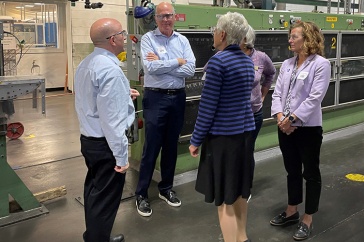
Professor of Marketing Ludwig Bstieler has devoted himself for more than a decade to understanding the inner workings of the complex relationship between universities and industry partners.
The latest in a series of studies commissioned by the Biotechnology Innovation Organization (BIO) and the Association of University Technology Managers (AUTM) found that academic-industry partnerships contributed as much as $1.33 trillion to U.S. industry gross output and $591 billion to the gross domestic product, while supporting 4,272,000 jobs during the years 1996–2015.
So, it’s not surprising that Professor of Marketing Ludwig Bstieler has devoted himself for more than a decade to understanding the inner workings of this complex relationship.
“Universities and industry have important differences,” says Bstieler. “What’s important to business is getting a product or technology out the door as soon as possible, maintaining intellectual property and being in command of the entire process. For university researchers, it’s publishing your findings…once they’re ready.”
To explore how these “odd couples” find common ground, Bstieler collected and analyzed dyadic data of 98 recent university-industry researcher collaborations to see how mutual trust in these inter-organizational relationships develops over time.
“With dyadic data, you interview both parties separately about their perceptions of communication, prioritizing, decision-making, and other behaviors involved in working together,” Bstieler explains.
Trust is fundamental to successful university-industry collaborations as these are exposed to a high amount of uncertainty over time. This is especially true in the cases of innovation and knowledge transfer, two critical components of such collaborations. “The more deviation between the perceptions of trust between the two partners, the more likely there’s an issue.”
Bstieler found that trust developed in phases throughout the early, middle, and mature stages of the relationship and that trust was formed on changing bases. Early trust tends to follow demographic similarity, such as gender, age, or education, but was not more important in nascent stage than in more mature relationships in this study. Midway through the relationship, however, strong reciprocal communication starts to form the basis for increasing trust.
“The more you talk to somebody and find out he knows his business, does what he says he’ll do, and does it on time, the more he earns your trust,” Bstieler says. “And once he knows you trust him, he’ll likely trust you as well.”
Gradually, however, decision-process similarity replaces this reciprocal communication in maintaining trusted collaborations over time, as communication is more effective in the early to intermediate stages.
While these findings should alert university-industry partners to these key factors for monitoring the relationship, they also offer a sober reminder, says Bstieler, that “these fundamentally different partners need to be mindful of the changing bases of mutual trust formation when successful collaboration is the goal.”
RECENT SELEC TED PUBLIC ATIONS
Bstieler, L., Gruen, T., & Akdeniz, B., et al. (2018). Emerging research themes in innovation and new product development: insights from the 2017 PDMA-UNH Doctoral Consortium. Journal of Product Innovation Management, 35.
Bstieler, L., Hemmert, M., & Barczak, G. (2017). The changing bases of mutual trust formation in inter-organizational relationships: a dyadic study of university-industry research collaborations. Journal of Business Research, 74.
Bstieler, L., Hemmert, M., & Barczak, G. (2015). Trust formation in university-industry collaborations in the US biotechnology industry: IP policies, shared governance, and champions. Journal of Product Innovation Management, 32.
-
Written By:
Dave Moore | Freelance Writer



















































